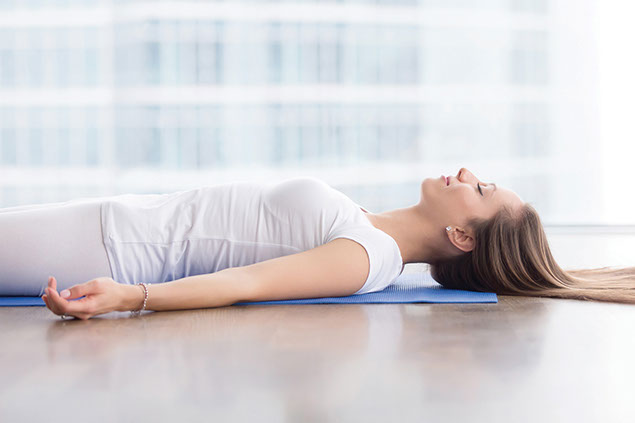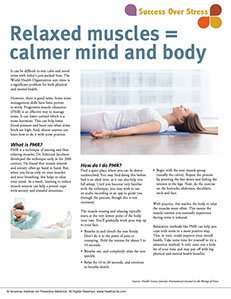SYMPTOM CHECKER
CONDITIONS
Male
Female
Child
Arm, Hand & Shoulder Concerns
Legs & Feet Concerns
Dental & Mouth Concerns
Ear & Nose
Eye Conditions
Head Conditions
Arm, Hand & Shoulder Concerns
Legs & Feet Concerns
Front
Back
Arm, Hand & Shoulder Concerns
Dental & Mouth Concerns
Ear & Nose
Eye Conditions
Head Conditions
Arm, Hand & Shoulder Concerns
Dental & Mouth Concerns
Ear & Nose
Eye Conditions
Head Conditions
Front
Back
Arm, Hand & Shoulder Concerns
Neck Links
Head & Neck Concerns
Arm, Hand & Shoulder Concerns
Neck Links
Head & Neck Concerns
Front
Back
Online Clinic
Wise Healthcare
Relaxed muscles = calmer mind and body
Print on Demand
It can be difficult to stay calm and avoid stress with today’s jam-packed lives. The World Health Organization says stress is a significant problem for both physical and mental health.
However, there is good news. Some stress management skills have been proven to work. Progressive muscle relaxation (PMR) is an effective way to manage stress. It can lower cortisol which is a stress hormone. This can help lower blood pressure and heart rate when stress levels are high. And, almost anyone can learn how to do it with some practice.
What is PMR?
PMR is a technique of tensing and then relaxing muscles. Dr. Edmund Jacobson developed the technique early in the 20th century. He found that muscle tension and anxiety often go hand in hand. But, when you focus only on your muscles and your breathing, this helps to relax your mind. As a result, learning to reduce muscle tension can help a person cope with anxiety and stressful situations.
How do I do PMR?
Find a quiet place where you can lie down undisturbed. You may find doing this before bed is an ideal time, as it can also help you fall asleep. Until you become very familiar with the technique, you may wish to use an audio recording or an app to guide you through the process, though this is not necessary.
The muscle tensing and relaxing typically starts at the very lowest point of the body: your toes. You’ll gradually work your way up to your face.
• Breathe in and clench the toes firmly. Don’t do it to the point of pain or cramping. Hold the tension for about 5 to 10 seconds.
• Breathe out, and completely relax the toes quickly.
• Relax for 10 to 20 seconds, and continue to breathe slowly.
• Begin with the next muscle group (usually the calves). Repeat the process by pointing the feet down and feeling the tension in the legs. Next, do the exercise on the buttocks, abdomen, shoulders, neck and face.
With practice, this teaches the body to relax the muscles more often. This means the muscle tension you normally experience during stress is reduced.
Relaxation methods like PMR can help you cope with stress in a more positive way. This, in turn, could improve your overall health. Take some time for yourself to try a relaxation method. It only costs you a little bit of your time and may pay off with big physical and mental health benefits.
Sources: Health Science Journal, International Journal on the Biology of Stress
This website is not meant to substitute for expert medical advice or treatment. Follow your doctor’s or health care provider’s advice if it differs from what is given in this guide.
The American Institute for Preventive Medicine (AIPM) is not responsible for the availability or content of external sites, nor does AIPM endorse them. Also, it is the responsibility of the user to examine the copyright and licensing restrictions of external pages and to secure all necessary permission.
The content on this website is proprietary. You may not modify, copy, reproduce, republish, upload, post, transmit, or distribute, in any manner, the material on the website without the written permission of AIPM.
2021 © American Institute for Preventive Medicine - All Rights Reserved. Disclaimer | www.HealthyLife.com
















































